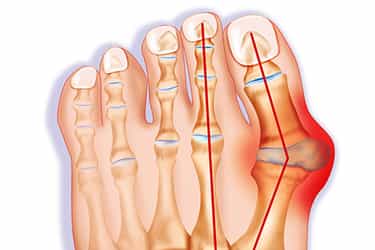Bunions

What is a bunion?
A bunion is a bony bump that forms on the joint at the base of your big toe. It occurs when some of the bones in the front part of your foot move out of place.
The bump is in fact the first metatarsal bone, which has drifted inwards, and this makes the big toe drift outwards towards the smaller toes. The bump sometimes gets bigger over time and can cause pain, redness and difficulty wearing shoes. Pain in the ball of the foot under the smaller toes is very common, and this is due to the transfer of pressures. The smaller toes can also become deformed over time.
What are the signs and symptoms of bunions?
You may have a bunion if you notice any of the following:
- a swollen, bony bump at the bottom of your big toe
- pain, swelling or soreness of your big toe
- rubbing on the inside of your shoe
- the bony growth on the joint sometimes causes your big toe to turn in towards your second toe.
- corns or calluses and red skin caused by your big toe and second toe overlapping.
What causes bunions?
The cause is not always known - there may be a deformity of the joint, called hallux valgus (hallux means big toe, valgus means bent outwards).
There is often a strong family history. Whilst we see bunions principally in females, they can also affect men. Having more mobile joints in general and flat feet often accompany bunions. Wearing tighter shoes and high heels for long periods does not cause bunions, but can certainly make them grow in size and become more painful.
Sometimes bunions are mistaken for arthritis in the big toe joint. With arthritis the joint usually grows in size and a bump is noted – more so on the top rather than the inside of the joint. We would normally start by arranging standing x-rays of your foot – which will show us the extent of the deformity and the presence or not of arthritis.
What treatments are available for bunions?
You can wear good supporting footwear to help relieve pain from bunions - narrow, pointed shoes are best avoided. Insoles can help particularly in patients with flat feet. Physiotherapy can be helpful to strengthen the muscles in your foot, and higher up the leg, which can make bunions less painful.
Other options including bunion splints, pads and bunion correctors may also relieve discomfort, however, these may not provide a long-term solution to your symptoms. If you're considering these options, speak to your GP for advice.
Painkillers can help, as can comfortable insoles and padding over the bunion. However, surgery is most effective if symptoms are not easing.
The operation to remove bunions is called a bunionectomy or a Keller's arthroplasty.
What will happen if I don’t get my bunions treated?
They may progress and the symptoms may worsen. A progressing bunion may be associated with pain and deformity of the second toe, metatarsalgia and osteoarthritic changes.
Years ago, people had to undergo painful surgery to remove bunions and endure up to a year of rehabilitation before they could wear normal shoes again. Now with modern surgical techniques available, the surgery is performed as a day case procedure and there is no need for plaster immobilization. Patients are up walking on the same day of surgery with a heel weight-bearing shoe fitted over their dressings.
